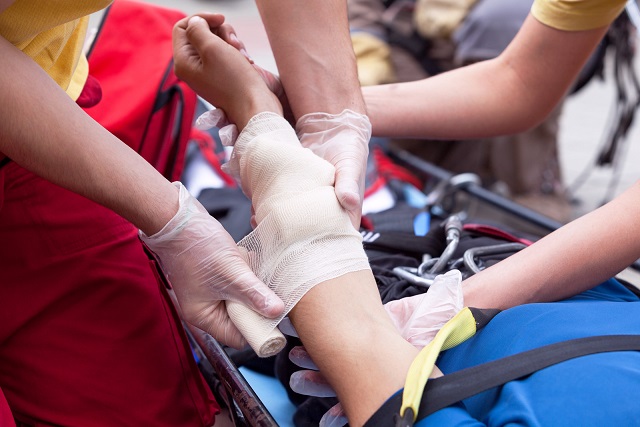Introduction
In our busy globe, emergency situations can strike without caution. Whether it's a small injury, a clinical emergency, or a deadly scenario, understanding how to provide first aid can make all the distinction. This is where a First Help course enters into play. Lots of people might question what they can gain from such training, and this short article aims to clarify that.
By joining in a First Help and CPR course, you do not simply learn about bandaging injuries or performing CPR; you furnish yourself with important abilities that might conserve lives. So, exactly what will you discover in a detailed program? Allow's study the details.


First Aid Basics: What You'll Learn in a Comprehensive Course
Understanding Initial Aid
What is Initial Aid?
First help refers to the first aid provided to someone suffering Hobart CPR Course Near Me from an injury or health problem until professional clinical help arrives. It includes various strategies and skills varying from easy wound like lifesaving methods like mouth-to-mouth resuscitation (Cardiopulmonary Resuscitation).
Importance of Emergency treatment Training
Why Should You Take an Emergency Treatment Course?
Taking a First Help course is important for several factors:
- Confidence: Recognizing exactly how to react in emergencies can instill confidence. Life-Saving Skills: The capacity to execute CPR or assist with choking can conserve lives. Career Advancement: Numerous careers require accreditation in initial aid. Community Obligation: Learning methods you can assist others effectively.
Overview of CPR
What is CPR?
CPR, or Cardiopulmonary Resuscitation, is an emergency treatment executed when someone's heartbeat or breathing has stopped. It integrates upper body compressions with rescue breaths to maintain blood flow and oxygenation until expert aid arrives.
The Framework of a Comprehensive Emergency Treatment Course
What Does a First Aid Course Include?
A well-rounded First Help and mouth-to-mouth resuscitation course usually covers the following subjects:
Introduction to First Aid Legal and Ethical Considerations Scene Safety Basic Life Assistance (BLS) CPR Techniques Choking Relief Wound Care Management Burn Treatment Managing Shock Recognizing Medical Emergencies Using an Automated External Defibrillator (AED)Legal Elements of First Aid
Are There Legal Implications Associated With Offering First Aid?
Yes, offering emergency treatment does lug legal duties referred to as "Good Samaritan legislations." These laws secure individuals that aid others in emergencies, provided their actions are reasonable and not reckless.
Scene Safety: The Very First Step
How Do You Ensure Scene Safety?
Ensuring scene security entails assessing the setting prior to approaching the victim:
- Look for potential risks (traffic, fire). Make sure it's safe for both you and the victim.
Basic Life Support (BLS)
What Function Does BLS Play in Emergency Situations?
Basic Life Support includes the principles of keeping life features up until additional medical assistance arrives. This area covers vital skills such as:
- Checking responsiveness Activating emergency services Performing premium chest compressions
Advanced mouth-to-mouth resuscitation Techniques
What Are Advanced Techniques Covered in Mouth-to-mouth Resuscitation Courses?
Advanced strategies may include:
- Two-rescuer CPR Use of barrier devices for rescue breaths Special factors to consider for infants and children
Choking Alleviation Techniques
How Do You Aid Someone Who is Choking?
Choking alleviation involves two important methods:
The Heimlich maneuver for adults. Back impacts and upper body thrusts for infants.Wound Care Management
How Do You Properly Take Care Of Wounds?
Effective injury monitoring entails:
- Cleaning the wound with saline or clean water. Applying antibiotic ointment. Covering it with sterilized dressings.
Burn Treatment
What Work Techniques for Treating Burns?
Burn treatment varies by degree:
Cool the shed under running water. Cover it with non-stick dressings. Seek medical focus for serious cases.Managing Shock
How Is Shock Acknowledged and Treated?
Recognizing shock includes seeking signs and symptoms like light skin, fast pulse, or confusion:
Lay the individual down. Elevate their legs unless there are injuries preventing this. Keep them relax till assistance arrives.Recognizing Clinical Emergencies
What Kinds of Medical Emergencies Ought To You Know Of?
Common medical emergencies include:
- Heart attacks Stroke Severe allergic reactions Understanding these problems helps you act quickly.
Using an Automated External Defibrillator (AED)
How Do You Use an AED Correctly?
Using an AED involves transforming it on, attaching pads according to pictures on the device, and complying with voice triggers carefully.
Importance of Continuous Learning
Why Is Constant Learning Important in Emergency Treatment Training?
Continuous learning guarantees you remain upgraded on finest methods and new protocols in emergency treatment care.
FAQs Regarding First Aid Courses
What Is Included in a Criterion First Aid Course?- A typical training course usually covers basic life assistance, wound administration, choking relief methods, and legal considerations.
- Most courses vary from 6 hours to 16 hours depending on the depth of content covered.
- Yes, upon effective conclusion of most programs, participants receive a first aid certificate, which is normally legitimate for 2 years.
- Yes! Lots of companies provide on-line training courses that supply versatile understanding environments while still being effective.
- Absolutely! Hands-on practice is essential for understanding abilities like upper body compressions and making use of AEDs effectively.
- Generally, there are no age constraints; nonetheless, individuals should be emotionally skilled to learn these life-saving abilities effectively.
Conclusion
Enrolling in a detailed emergency treatment course outfits individuals with crucial understanding that can conserve lives throughout emergencies-- whether at home, work, or out in public spaces! From comprehending standard life assistance treatments such as mouth-to-mouth resuscitation to learning how to handle injuries properly or acknowledge indicators of shock-- these courses supply important training that any person can profit from!
As we navigate via our daily lives full of unpredictability-- what much better method than preparing ourselves via knowledge gotten from organized training sessions concentrated on conserving lives?
In verdict-- if you're pondering taking up any type of kind of first-aid training-- never ever be reluctant! Furnish yourself today with these powerful devices because preparedness absolutely makes all the distinction when every 2nd counts!
